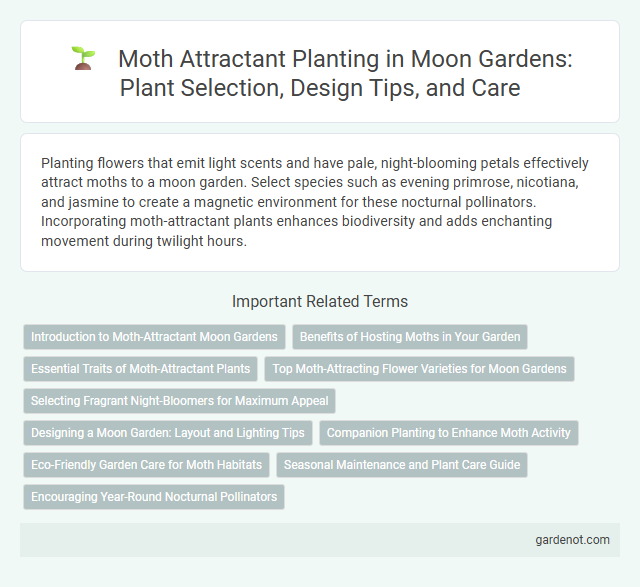Planting flowers that emit light scents and have pale, night-blooming petals effectively attract moths to a moon garden. Select species such as evening primrose, nicotiana, and jasmine to create a magnetic environment for these nocturnal pollinators. Incorporating moth-attractant plants enhances biodiversity and adds enchanting movement during twilight hours.
Introduction to Moth-Attractant Moon Gardens
Moth-attractant moon gardens use white and pale-colored flowers that reflect moonlight, enhancing nighttime visibility and appeal to nocturnal moths. Plants like evening primrose, nicotiana, and jasmine release strong fragrances after dusk, attracting various moth species for pollination. Creating a moon garden involves selecting native, nectar-rich plants to support moth biodiversity and promote nighttime pollinator activity.
Benefits of Hosting Moths in Your Garden
Planting moth attractant species such as evening primrose and jasmine enhances nocturnal pollination, supporting biodiversity in your Moon garden. Moths contribute to the ecosystem by serving as food for bats and birds, promoting a balanced environment. Incorporating these plants fosters a thriving habitat that enriches soil health and encourages natural pest control.
Essential Traits of Moth-Attractant Plants
Moth-attractant plants exhibit essential traits such as strong nocturnal fragrance, pale or white blossoms that reflect moonlight, and abundant nectar production to lure moths during nighttime. These plants often have tubular flower shapes suited for moths' long proboscises and emit volatile organic compounds that align with moth sensory preferences. Optimal species include evening primrose, nicotiana, and night-blooming jasmine, making them ideal for enhancing biodiversity in moon gardens.
Top Moth-Attracting Flower Varieties for Moon Gardens
Top moth-attracting flower varieties for moon gardens include evening primrose, moonflower, and jasmine, all known for their strong nighttime fragrance and pale blossoms that glow under moonlight. These plants emit sweet scents and produce white or light-colored flowers that enhance visibility for nocturnal moths, promoting pollination. Incorporating nicotiana and four o'clocks further enriches the moon garden's allure by attracting diverse moth species with their aromatic, trumpet-shaped blooms.
Selecting Fragrant Night-Bloomers for Maximum Appeal
Selecting fragrant night-blooming plants like Nicotiana, Jasmine, and Evening Primrose maximizes moth attraction in a moon garden by emitting strong scents during dusk. These species release volatile organic compounds that are highly appealing to nocturnal pollinators, enhancing nighttime biodiversity. Strategic placement in shaded, cool areas further intensifies fragrance diffusion, ensuring a vibrant moth population.
Designing a Moon Garden: Layout and Lighting Tips
Incorporate moth-attractant plants such as evening primrose, nicotiana, and honeysuckle in crescent or circular garden beds to maximize their nocturnal appeal. Utilize soft, low-intensity lighting with blue or ultraviolet LED bulbs strategically placed to highlight floral clusters without overpowering the natural glow of moonlight. Create layered plantings with taller moth-friendly species in the back and shorter blooms in front to enhance airflow and scent diffusion, optimizing the garden's nighttime ambiance.
Companion Planting to Enhance Moth Activity
Companion planting in moon gardens significantly enhances moth activity by incorporating nectar-rich flowers like evening primrose, nicotiana, and verbena that bloom at night. These plants emit strong fragrances and provide essential food sources, attracting moths for pollination and increasing biodiversity. Strategic placement of host plants such as willow or nettle further supports moth larvae, creating a thriving ecosystem.
Eco-Friendly Garden Care for Moth Habitats
Planting night-blooming flowers such as evening primrose, nicotiana, and verbena attracts moths by providing essential nectar sources while supporting their natural behaviors. Using native plants reduces pesticide need, fostering a sustainable environment that promotes healthy moth populations and biodiversity. Incorporating eco-friendly garden care practices like organic mulching and avoiding chemical pesticides ensures the preservation of delicate moth habitats and encourages their role in pollination.
Seasonal Maintenance and Plant Care Guide
Moth attractant planting in a moon garden requires regular seasonal maintenance to ensure vibrant blooms and healthy foliage throughout the year. Pruning spent flowers and removing dead leaves in late summer promotes new growth and extends the blooming period. Applying organic mulch and monitoring soil moisture during dry spells supports plant vitality and enhances nighttime moth activity.
Encouraging Year-Round Nocturnal Pollinators
Planting night-blooming jasmine, evening primrose, and moonflower in a moon garden enhances the habitat for nocturnal pollinators like moths by providing continuous nectar sources throughout the year. These moth attractant species emit strong, sweet fragrances in the evening, which are essential for drawing pollinators during nighttime hours and supporting biodiversity. Maintaining diverse native plants with overlapping bloom periods ensures year-round foraging opportunities for moth populations and promotes ecological balance in nocturnal ecosystems.
Moth attractant planting Infographic

 gardenot.com
gardenot.com